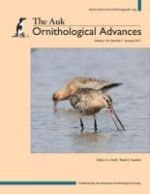Yellow-shafted Flickers (Colaptes auratus auratus subspecies group of the Northern Flicker) occasionally have orange to red flight feathers in eastern North America far from the hybrid zone with the Red-shafted Flicker (C. a. cafer subspecies group). Blocks of feathers of anomalous color tend to show bilateral symmetry and may differ from one year to the next in the same bird. It has been suggested that hybridization with cafer must be the source of the red color and that selection for that color could explain the high incidence of red or orange shafts in eastern flickers in some localities. Complex, though largely unproven, physiological mechanisms have been hypothesized to explain the variegated look. We evaluated a simpler, dietary explanation for the variation: that the pigment rhodoxanthin acquired exogenously at the time of feather molt comes to rest alongside the carotenoids normally present in these feathers. An exogenous source of rhodoxanthin exists in the berries of nonnative bush honeysuckles (Lonicera spp.) now naturalized in eastern North America and the American Midwest. We confirm the presence of rhodoxanthin and a probable metabolite, rather than the 4-keto-carotenoids found in the Red-shafted Flicker, in the red flight feathers of 2 Yellow-shafted Flickers from eastern North America. In these individuals, dietary rhodoxanthin appeared to interfere with the production of lutein, the main carotenoid in auratus. A fairly abrupt appearance of red color in earlier-molted primaries (usually p4 or p5) followed by its gradual fading in subsequent primaries in a large series of aberrantly colored flickers from eastern North America and the American Midwest supports a dietary explanation. We use data on the timing of replacement of primaries in the Northern Flicker at Manomet in Plymouth, eastern Massachusetts, to infer that these aberrantly colored Yellow-shafted Flickers on average acquired the unusual red pigment in early August.
How to translate text using browser tools
12 October 2016
Diet explains red flight feathers in Yellow-shafted Flickers in eastern North America
Jocelyn Hudon,
Robert J. Driver,
Nathan H. Rice,
Trevor L. Lloyd-Evans,
Julie A. Craves,
Daniel P. Shustack

The Auk
Vol. 134 • No. 1
January 2017
Vol. 134 • No. 1
January 2017
bush honeysuckles
carotenoids
Colaptes auratus
diet
Lonicera spp.
Northern Flicker
rhodoxanthin




